History
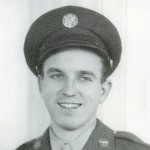 My children and grandchildren have always known that my dad fought in World War II, but I find that maybe they don’t fully know what his part was, or how I feel about it. That is not surprising when you think about the fact that my children, grandchildren, and indeed, even my sisters and I, were not even born when all that took place seventy years ago today. I am pleased that my grandchildren know that their great grandpa fought in World War II, because that tells me that we who are older and at least know about that time in history, have done our jobs, in teaching this youngest generation of our family about the history their family was involved in…pretty well anyway. I was also very proud of my grandson, Chris, because he was interested enough to ask the questions he did about his great grandpa’s service years.
My children and grandchildren have always known that my dad fought in World War II, but I find that maybe they don’t fully know what his part was, or how I feel about it. That is not surprising when you think about the fact that my children, grandchildren, and indeed, even my sisters and I, were not even born when all that took place seventy years ago today. I am pleased that my grandchildren know that their great grandpa fought in World War II, because that tells me that we who are older and at least know about that time in history, have done our jobs, in teaching this youngest generation of our family about the history their family was involved in…pretty well anyway. I was also very proud of my grandson, Chris, because he was interested enough to ask the questions he did about his great grandpa’s service years.
This morning, my grandson Chris sent me a text, tip toeing a bit, because he didn’t know how I 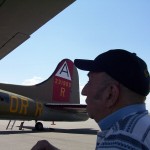 would feel talking about this part of me Dad’s life, and asked me if my dad was involved in the D-Day maneuvers. I immediately told him that I was very proud of the part my Dad had played in World War II, and that his squadron had provided air cover as the troops stormed the beaches of Normandy. I sent him the links to other stories I had written about my Dad’s World War II service years, and he was amazed at all his great grandpa had done. I know how he feels. The first time I was told about all the things my dad had done, I was amazed too…and very proud.
would feel talking about this part of me Dad’s life, and asked me if my dad was involved in the D-Day maneuvers. I immediately told him that I was very proud of the part my Dad had played in World War II, and that his squadron had provided air cover as the troops stormed the beaches of Normandy. I sent him the links to other stories I had written about my Dad’s World War II service years, and he was amazed at all his great grandpa had done. I know how he feels. The first time I was told about all the things my dad had done, I was amazed too…and very proud.
There are a number of men, and maybe even women, in our family who served their country in World War II, and were involved in D-Day maneuvers, and each one is a hero in my eyes. This was such an important day in our history, as was the war it was a part of, and I would hate to think that our grandchildren and great grandchildren would never know of the sacrifice those brave men  made. I would hate to think that the heroes of this and other wars would be forgotten by a nation too busy with their own lives and interests to take the time to look back in history and see for themselves exactly what took place. I know many people find history to be dull, dry, and boring in school, but as we age, and experience a few wars, weather events, earthquakes, and other changes in our nation, we realize that maybe we really need to take a look back and see just how we came to be the great nation we are…and remember the sacrifices made by so many to get us where we are today. I want to thank all the men and women who took part in D-Day, World War II, and all the other wars our nation has been a part of. We are great because of God and you!!
made. I would hate to think that the heroes of this and other wars would be forgotten by a nation too busy with their own lives and interests to take the time to look back in history and see for themselves exactly what took place. I know many people find history to be dull, dry, and boring in school, but as we age, and experience a few wars, weather events, earthquakes, and other changes in our nation, we realize that maybe we really need to take a look back and see just how we came to be the great nation we are…and remember the sacrifices made by so many to get us where we are today. I want to thank all the men and women who took part in D-Day, World War II, and all the other wars our nation has been a part of. We are great because of God and you!!
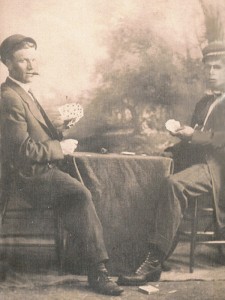 In years gone by, the choices for recreational activities were pretty limited. There weren’t any radio stations to play music for dances all the time, things like television and computers were still in the future. So, what did people do to entertain themselves. Of course, there were things like the occasional barn dance, and the county fair, but in reality, there were not a lot of choices. The saloons wee an option for the men, but not for the nice women…in fact they were embarrassed if anyone knew that their men were in the saloon at all. Not that the men were very influenced by how the women felt about it. If they wanted to go in there, they did, and that was it.
In years gone by, the choices for recreational activities were pretty limited. There weren’t any radio stations to play music for dances all the time, things like television and computers were still in the future. So, what did people do to entertain themselves. Of course, there were things like the occasional barn dance, and the county fair, but in reality, there were not a lot of choices. The saloons wee an option for the men, but not for the nice women…in fact they were embarrassed if anyone knew that their men were in the saloon at all. Not that the men were very influenced by how the women felt about it. If they wanted to go in there, they did, and that was it.
The saloon was where the men could get a drink and socialize with friends, or they could play poker. The other things that happened in the saloon, such as the womanizing and fighting, were not talked about in good moral company. That didn’t mean that all men engaged in such immoral activities, but I’m sure some did. Of course, just having those dance hall girls in the place, is enough to make most women suspect.
Poker was pretty much the card game of choice in the saloons, but maybe some of the men played it elsewhere. Back then, I doubt if the women would be caught dead playing poker, because it was probably considered a sin. These days, playing poker is considered simply a fun activity, and it is played in homes, casinos, and even bowling alleys. Lots of people play, and have a great time doing it. Times were just different back then, and sometimes I wonder if that wasn’t a better thing. There seemed to be an innocence then that we don’t even have in our grade school years in school now.
Nevertheless, I don’t think there is anything wrong with playing cards, or even poker for that matter. I play a little poker at the bowling, alley, which is much different than regular poker, in that you just draw the cards when you get a strike or spare. Personally I’d rather play, Cribbage or Spades, over poker in most situations, but in all reality, I’m not much on playing cards anymore. I suppose that is because there is too many other activities to occupy the mind these days. I have to think I like that better than I would have the days when cards were the main entertainment.
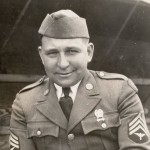 My dad, Aunt Laura, Uncle Bill, and Aunt Ruth had a half brother, of whom I was barely aware until recent years. I think I had heard about him, but somehow it really didn’t register in my mind, but rather seemed like someone who was somehow connected to someone else. While going through my dad’s pictures, we came across a picture of a man named Norman. We were pretty sure this was Dad’s half brother, and then when I was looking through my Uncle Bill’s family history books, our suspicions were confirmed. He looks like a very nice man, and I became very curious about him. I began researching him on Ancestry.com, and found that there was relatively little information, or at least that I could be sure of by documentation. I knew that he was born on May 25, 1906 in Flambeau, Wisconsin, and that he passed away on October 26, 1977 in Richmond, Virginia. Since his birthday was coming up, I decided that I wanted to showcase him for his birthday…but, it was looking like it was going to be a very short story. I decided to ask some of the people on the Spencer Historical and Genealogical Society’s Facebook page to see if they could help. What an amazing idea that turned out to be. I quickly got a response from David Lawrence, and he had a wealth of information to give me.
My dad, Aunt Laura, Uncle Bill, and Aunt Ruth had a half brother, of whom I was barely aware until recent years. I think I had heard about him, but somehow it really didn’t register in my mind, but rather seemed like someone who was somehow connected to someone else. While going through my dad’s pictures, we came across a picture of a man named Norman. We were pretty sure this was Dad’s half brother, and then when I was looking through my Uncle Bill’s family history books, our suspicions were confirmed. He looks like a very nice man, and I became very curious about him. I began researching him on Ancestry.com, and found that there was relatively little information, or at least that I could be sure of by documentation. I knew that he was born on May 25, 1906 in Flambeau, Wisconsin, and that he passed away on October 26, 1977 in Richmond, Virginia. Since his birthday was coming up, I decided that I wanted to showcase him for his birthday…but, it was looking like it was going to be a very short story. I decided to ask some of the people on the Spencer Historical and Genealogical Society’s Facebook page to see if they could help. What an amazing idea that turned out to be. I quickly got a response from David Lawrence, and he had a wealth of information to give me.
He told me that Norman was married to a woman named Elizabeth, but it didn’t appear that they ever had children. He mentioned that he had been stationed in Oahu, Hawaii in World War II. Then he said that he had worked for the Virginia State Police as a radio technician in 1850. I had found Uncle Norman’s grave on FindaGrave.com a while back, and a reference to Elizabeth that I couldn’t confirm on Ancestry.com. This all gave me new motivation to find out more. I first went to FindaGrave.com and found Elizabeth’s grave, but all it said was Elizabeth H…no last name, and called her, simply his wife. I found that a bit odd, but then I started thinking about the Virginia State Police, and decided that maybe I could get more information by calling them. This also turned out to be an amazing idea. I was quickly connected to the Human Resource Records Department, and within just a few minutes they read me all of the information on my uncle’s employment card…and there was more that just his employments history. His parents names, which I already knew, were listed, but also Elizabeth’s last name, which was Hoover. They had his service years, August 25, 1925 to March 31, 1950, when he retired at the rank of captain. They also had, of course, his employment years, August 17, 1953 to June 1, 1971, when he retired at the age of 65. I couldn’t believe all this information had come my way, by simply reaching out to two key sources. It was an exciting day indeed.
I was curious as to what Uncle Norman might have done as a radio technician, so I did some research on that occupation and found that they design, set up, operate and maintain equipment and radios used for transmitting. This tells me that he probably worked on s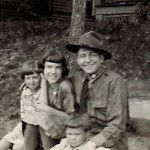 ystems for broadcasting information to and from the police officers of the Virginia State Police. I’m quite sure that the equipment he worked on back then would almost seem like a home built ham radio these days, compared to the equipment the police departments use today, and in todays world, his job might be a mix of those old radio technicians, and the work my cousin, Tim Fredrick, who is a half grand nephew of Uncle Norman’s, if I have my terminology right. I’ll bet he saw a lot of changes in that industry over his years of being involved in it. I wish I could have talked to him about it, but that was not to be. Today would have been my Uncle Norman’s 108th birthday. I’m really sorry I never got to know him, but happy birthday in Heaven Uncle Norman.
ystems for broadcasting information to and from the police officers of the Virginia State Police. I’m quite sure that the equipment he worked on back then would almost seem like a home built ham radio these days, compared to the equipment the police departments use today, and in todays world, his job might be a mix of those old radio technicians, and the work my cousin, Tim Fredrick, who is a half grand nephew of Uncle Norman’s, if I have my terminology right. I’ll bet he saw a lot of changes in that industry over his years of being involved in it. I wish I could have talked to him about it, but that was not to be. Today would have been my Uncle Norman’s 108th birthday. I’m really sorry I never got to know him, but happy birthday in Heaven Uncle Norman.
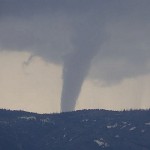 Yesterday’s rare tornado on Casper Mountain while not scary, because I didn’t know about it until it was over, did take me back a in time a bit, however. A number of years ago, my Aunt Ruth and Uncle Jim Wolfe were at my mom’s house visiting, we were under a tornado watch. No one was worried about it because it was only a watch, and we didn’t expect anything to come of it. I think we were under the mistaken assumption that we would never have a tornado here…at least I think I was. I’m sure the adults knew that a tornado could happen anywhere, but I was a kid, and I still wanted that cushion of protection. It’s a lot more comfortable to a child to think that these bad things can never come here, and you don’t want your dream world shattered. All too soon you reach an age where you know that storms like these are possible anywhere, and you become watchful, just like my Aunt Ruth was.
Yesterday’s rare tornado on Casper Mountain while not scary, because I didn’t know about it until it was over, did take me back a in time a bit, however. A number of years ago, my Aunt Ruth and Uncle Jim Wolfe were at my mom’s house visiting, we were under a tornado watch. No one was worried about it because it was only a watch, and we didn’t expect anything to come of it. I think we were under the mistaken assumption that we would never have a tornado here…at least I think I was. I’m sure the adults knew that a tornado could happen anywhere, but I was a kid, and I still wanted that cushion of protection. It’s a lot more comfortable to a child to think that these bad things can never come here, and you don’t want your dream world shattered. All too soon you reach an age where you know that storms like these are possible anywhere, and you become watchful, just like my Aunt Ruth was.
As we were visiting, no one was really paying attention to the weather. Suddenly, my Aunt Ruth jumped up and ran to the back door. She looked out the window and said, “There is a tornado somewhere!!” I remember thinking, “No way!! We don’t get those here!!” She insisted that there had been one, but with no way to confirm it right then, they went back to their conversation. I, on the other hand felt a little apprehensive for the rest of the evening. I kept thinking, “Tornados don’t happen here, do they…or do they? Is it save to be here? Should we be going somewhere to hide r something?” Still the adults didn’t seem too concerned, so I went back to what I was doing too, but the memory of that moment has really never left me. I can still vividly see my Aunt Ruth standing at the back door, looking at the sky for clues as to the location of the tornado. I can still hear her voice, clearly saying that there was a tornado somewhere. She was so sure of it
Later that night, as we were watching the news, the weather man said that there had been a tornado on the mountain. I was a little shaken up by that report. The memory of that moment has lived in my memory files for all those years. I don’t know exactly how she knew it that day, but she did. I think I was a little bit in awe of her knowledge of storm systems. I suppose that was because she had been right about it. Now, of course we have things like radar, and 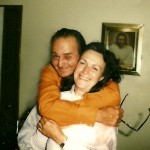 rotation patterns to tell us ahead of time that something is coming, but I am here to tell you that those systems don’t always do exactly what they are supposed to do. Yesterday’s tornado on Casper Mountain did not set of any of the warning systems. I wondered how that could be, until I found out that the tornado was called a Land Spout Tornado, and apparently those don’t show a rotation pattern that can be picked up by radar. So even with all the warning systems we have, no system is fool proof, and there can be the rogue storm the goes against everything known to man concerning storms. Still, they happen. I suppose that then the only warning system is a person to can feel the weather, like Aunt Ruth.
rotation patterns to tell us ahead of time that something is coming, but I am here to tell you that those systems don’t always do exactly what they are supposed to do. Yesterday’s tornado on Casper Mountain did not set of any of the warning systems. I wondered how that could be, until I found out that the tornado was called a Land Spout Tornado, and apparently those don’t show a rotation pattern that can be picked up by radar. So even with all the warning systems we have, no system is fool proof, and there can be the rogue storm the goes against everything known to man concerning storms. Still, they happen. I suppose that then the only warning system is a person to can feel the weather, like Aunt Ruth.
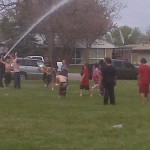
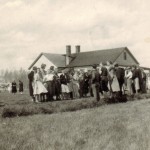 As the school year comes to a close, the students start thinking of their long awaited and well earned summer break. While the school year ends on different days for different schools, for different grades, and in different states, the end of the school year pretty much means the same thing to the kids…play day. Whether it is the grade school kids running through the fire hose or the high schoolers watching movies, the last day of school or even the last week of school is often very counterproductive. Often the grades have to be turned in before school is even out, so there is simply nothing more to do on the last day of school, finding creative ways to entertain the children until the school day is over.
As the school year comes to a close, the students start thinking of their long awaited and well earned summer break. While the school year ends on different days for different schools, for different grades, and in different states, the end of the school year pretty much means the same thing to the kids…play day. Whether it is the grade school kids running through the fire hose or the high schoolers watching movies, the last day of school or even the last week of school is often very counterproductive. Often the grades have to be turned in before school is even out, so there is simply nothing more to do on the last day of school, finding creative ways to entertain the children until the school day is over.
The last day of school in years gone by was a bit different in some aspects, since movies didn’t exist, nor did the type of fire trucks we have today. Nevertheless, the day was usually spent outside, having a picnic, playing games, or just visiting with friends and making plans for their summer. Other things were different back then too. Often the schools were very small, and all the grades were together with one teacher. That could have been a challenge, no only in class time, but on the play day activities too. Nevertheless, kids will find things to do. The biggest problem the teacher faces is keeping track of everyone on these outdoor events, especially if they took a field trip, but then teachers have been handling that job for many years.
For the most part, kids don’t care very much what play day activities there are, as long as they aren’t required to sit indoors studying on such a beautiful day. I can’t blame them. There will be plenty of time to work year round, raise a family, and do all the other things that go along with being an adult. For today, they get to be kids looking forward to the warm, carefree days of summer 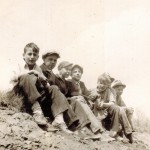
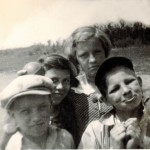 that are coming. Really, the teachers might just as well not plan any lessons, because which kid would be into that anyway…none, not even the straight A student. They all have their minds on sleeping in, swimming, hanging out with friends, camping, fishing, bike riding, skateboarding…you know just having fun. Play day marks the final day of school for the year, so let the good times of summer begin!!
that are coming. Really, the teachers might just as well not plan any lessons, because which kid would be into that anyway…none, not even the straight A student. They all have their minds on sleeping in, swimming, hanging out with friends, camping, fishing, bike riding, skateboarding…you know just having fun. Play day marks the final day of school for the year, so let the good times of summer begin!!
 You don’t grow up in central Wyoming without making at least one and more likely several trips to Independence Rock. It is a favorite for school field trips, and family outings as well…or at least it was when I was growing up. My family has climbed all over that rock looking at the names of the immigrants who passed by their on their way west. They would carve their name in the rock, as a way of saying, “I was here, in this place, on this date in history.” They had no way of knowing if anyone would ever see their name or care to wonder about who they were, but they wanted to mark their presence in time anyway. Lots of people have done that over the years, although these days people often use spray paint on the rocks or walls of a place, or even a sharp object on the stalls of a bathroom, which I have never been able to figure out. I mean, who cares about that. It’s just weird. Of course the difference is that the people who do that now are looked on with disdain, for defacing public property, but the immigrants heading to the old west were viewed as pioneers making their mark in history. I have to agree with that analogy, because graffiti is not like a historical record carved into a rock after all.
You don’t grow up in central Wyoming without making at least one and more likely several trips to Independence Rock. It is a favorite for school field trips, and family outings as well…or at least it was when I was growing up. My family has climbed all over that rock looking at the names of the immigrants who passed by their on their way west. They would carve their name in the rock, as a way of saying, “I was here, in this place, on this date in history.” They had no way of knowing if anyone would ever see their name or care to wonder about who they were, but they wanted to mark their presence in time anyway. Lots of people have done that over the years, although these days people often use spray paint on the rocks or walls of a place, or even a sharp object on the stalls of a bathroom, which I have never been able to figure out. I mean, who cares about that. It’s just weird. Of course the difference is that the people who do that now are looked on with disdain, for defacing public property, but the immigrants heading to the old west were viewed as pioneers making their mark in history. I have to agree with that analogy, because graffiti is not like a historical record carved into a rock after all.
Independence Rock is located in southwestern Natrona County along Highway 220, a little 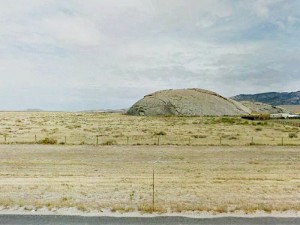 over 55 miles from Casper, which is why many Casperites have been there so many times. It is a huge granite rock approximately 130 feet high, 1,900 feet long and 850 feet wide. It basically sticks up in the middle of an otherwise quite flat area on the prairie, with the mountains in the distance. I suppose that was why the pioneers decided to carve their names there. After a long day of travel, it was a good place to camp, with one side well protected and a great place to keep a watchful eye out for Indians or outlaws. The children could play on the rock, and that would put them out of their mothers’ hair while dinner was prepared. Some people say that it looks like a huge whale in the middle of the prairie, and I can say I must agree. Because of all the names carved in the rock, it was dubbed “Register of the Desert” by Peter DeSmet in 1840.
over 55 miles from Casper, which is why many Casperites have been there so many times. It is a huge granite rock approximately 130 feet high, 1,900 feet long and 850 feet wide. It basically sticks up in the middle of an otherwise quite flat area on the prairie, with the mountains in the distance. I suppose that was why the pioneers decided to carve their names there. After a long day of travel, it was a good place to camp, with one side well protected and a great place to keep a watchful eye out for Indians or outlaws. The children could play on the rock, and that would put them out of their mothers’ hair while dinner was prepared. Some people say that it looks like a huge whale in the middle of the prairie, and I can say I must agree. Because of all the names carved in the rock, it was dubbed “Register of the Desert” by Peter DeSmet in 1840.
Independence Rock was a favorite place to go rock hunting as far as my Grandpa George Byer was concerned, and the family went there quite a bit. It wasn’t a historical site then. Now, it is illegal to take rocks from that area, of course Grandpa would have never taken anything that had a name carved in it anyway. I’m sure that many of his kids have passed that tradition on to their kids, although, I don’t think many of the grandchildren take their kids there much anymore. It’s not that we wouldn’t think Independence Rock is interesting, 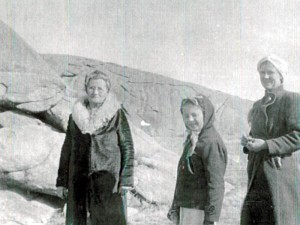 because I think many of us would, except that for a time you weren’t allowed to climb the rock to see the names recorded there. It was a little glitch in people’s thinking I think, and it made Independence Rock a lot less interesting to this generation. The time when climbing on the rock was prohibited came about because they didn’t want footsteps to kill the lichen, but I think they have changed that now, because the lichen was obscuring the names, and defacing the rock in it’s own way. I don’t go there much these days, but it will always hold a place in my memory files, because of all the fun we had there when Dad would take us to learn about history.
because I think many of us would, except that for a time you weren’t allowed to climb the rock to see the names recorded there. It was a little glitch in people’s thinking I think, and it made Independence Rock a lot less interesting to this generation. The time when climbing on the rock was prohibited came about because they didn’t want footsteps to kill the lichen, but I think they have changed that now, because the lichen was obscuring the names, and defacing the rock in it’s own way. I don’t go there much these days, but it will always hold a place in my memory files, because of all the fun we had there when Dad would take us to learn about history.![]()
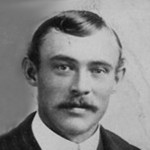 Recently, my interest turned to the ancestry of the Schulenberg side of my family, when I was contacted by a more famous member of the family, who I will not name at this point, as I have not asked his permission to do so, and so I will respect his privacy. He wondered if we might be related, and I told him that I expected that we probably are. Since that time, I have been looking back on that side of the family. I knew that our side of the Schulenberg family came to America aboard the SS Moltke in 1895, when Max Heinrich Johann Carl Schulenberg arrived on that ship at the tender age of 17 years, without an adult to accompany him…a bold move for a young man. He arrived in New York City, like so many other immigrants. Before too long he had made his way to Blair,Nebraska, where he met and married Julia Doll on December 16, 1902. The couple would have ten children, the oldest of which was Andrew, my husband, Bob’s grandfather. The family would eventually settle in Forsyth, Montana, where there are still family members living to this day.
Recently, my interest turned to the ancestry of the Schulenberg side of my family, when I was contacted by a more famous member of the family, who I will not name at this point, as I have not asked his permission to do so, and so I will respect his privacy. He wondered if we might be related, and I told him that I expected that we probably are. Since that time, I have been looking back on that side of the family. I knew that our side of the Schulenberg family came to America aboard the SS Moltke in 1895, when Max Heinrich Johann Carl Schulenberg arrived on that ship at the tender age of 17 years, without an adult to accompany him…a bold move for a young man. He arrived in New York City, like so many other immigrants. Before too long he had made his way to Blair,Nebraska, where he met and married Julia Doll on December 16, 1902. The couple would have ten children, the oldest of which was Andrew, my husband, Bob’s grandfather. The family would eventually settle in Forsyth, Montana, where there are still family members living to this day.
But what of the German half of the Schulenberg family. They had a longstanding heritage in Oldenburg, Germany, where the family owned a farm since 1705, when the first known Schulenberg owner,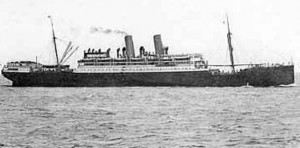 Johann Schulenberg shows up in records as the owner. The farm was rather large and still stands to this day. It has been well maintained, and is in fact, more beautiful today than it was when Johann owned it. I’m sure that has to do with all the modern equipment and products we have today to enhance the natural beauty of a home and its grounds. Nevertheless, the farm was a productive place in 1705 too.
Johann Schulenberg shows up in records as the owner. The farm was rather large and still stands to this day. It has been well maintained, and is in fact, more beautiful today than it was when Johann owned it. I’m sure that has to do with all the modern equipment and products we have today to enhance the natural beauty of a home and its grounds. Nevertheless, the farm was a productive place in 1705 too.
The furthest record of the family line that I have found to date is Vitter Schulenberg, who actually hailed from Schulenberg, Germany, where I expect the family originated, because as most of us know, before last names existed, people were known by the town they came from, such as Jesus of Nazareth. The Schulenberg family had been known in prior years as von der Schulenberg, which translates from Schulenberg, meaning the town of Schulenberg, Germany which is located in the district of Goslar in Lower Saxony, Germany, I don’t know if those people whose last name is spelled Schulenburg came from the same family or not, but I would expect that it is quite likely, because when people came to America, they were told to 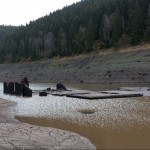 Americanize their name, and there was no regulation as to how to do that, so some went one way and others went another way.
Americanize their name, and there was no regulation as to how to do that, so some went one way and others went another way.
I also found out that there was an older village of Schulenberg, which only appears in the fall, when the lake is at its lowest point. The lake (der Okertalsperre) or reservoir which was constructed in 1953, resulting in the flooding of the old village. That fascinated me. I found this picture of the ruins on Google Earth (taken by Harz Geist), and either there is not much left of the old village, or it was very small, which almost makes me wonder if it was originally a farm named Schulenberg, that grew into a village…but that is the subject of another story, for another day.
 When my sisters and I were teenagers, the mini skirt and hot pants were all the rage…much to my mother’s dismay. She always felt like they were a little bit too risqué. Of course, we completely disagreed with her, and in fact, thought she was just being very old fashioned, and really a bit ridiculous. Everyone was wearing these new styles, and we didn’t want to be thought of as the nerds of the school…not to mention the fact that they were cute styles, and we wanted to look as cute as the other girls did. It was about this time in my life, that I began to see the value of skirts, over dresses. You simply couldn’t roll a dress up to turn it into a mini dress, but you could do that with a skirt. So to appease Mom, the skirt was knee length at home, but soon became a serious mini skirt…and before I went into school too. The old saying, “I wouldn’t be caught dead in that” definitely applied when it came to knee length or longer skirts…until the maxi skirt came out that is. The problem is that once a child leaves the house, parents just don’t have total control anymore, and most teenagers will go a long way toward avoiding conflict, if it’s possible. I wasn’t the only girl rolling my skirt either. Every girl whose mother said no, was doing it. Of course, shorts were a little easier to get away with, but Mom still thought they should be a little longer. Her problem was that longer shorts were harder to find…thankfully!!!
When my sisters and I were teenagers, the mini skirt and hot pants were all the rage…much to my mother’s dismay. She always felt like they were a little bit too risqué. Of course, we completely disagreed with her, and in fact, thought she was just being very old fashioned, and really a bit ridiculous. Everyone was wearing these new styles, and we didn’t want to be thought of as the nerds of the school…not to mention the fact that they were cute styles, and we wanted to look as cute as the other girls did. It was about this time in my life, that I began to see the value of skirts, over dresses. You simply couldn’t roll a dress up to turn it into a mini dress, but you could do that with a skirt. So to appease Mom, the skirt was knee length at home, but soon became a serious mini skirt…and before I went into school too. The old saying, “I wouldn’t be caught dead in that” definitely applied when it came to knee length or longer skirts…until the maxi skirt came out that is. The problem is that once a child leaves the house, parents just don’t have total control anymore, and most teenagers will go a long way toward avoiding conflict, if it’s possible. I wasn’t the only girl rolling my skirt either. Every girl whose mother said no, was doing it. Of course, shorts were a little easier to get away with, but Mom still thought they should be a little longer. Her problem was that longer shorts were harder to find…thankfully!!!
We weren’t the first generation to wear the mini skirt, short shorts, and other risqué clothing choices, but to hear my mother talk, we were. In fact, Mom went through a  period of time in her own life when she wanted to wear the things the other girls were wearing. Her friends were wearing two piece bathing suits, which were considered very risqué at the time…little did they know that the string bikini was on it’s way and it would make their two piece bathing suit, that covered most of the midriff, look very conservative indeed. Nevertheless, my mom was in a little bit different position than we were, because it is hard to hide the way a bathing suit looks, and it isn’t an item you wear to school, so changing its looks was much harder. Still, she told me that the other girls were wearing a two piece, and she sure wanted to, but was not allowed. The two piece bathing suit was just too risqué…according to my grandmother. Poor Mom…there seemed no way out of her dilemma, and there’s no way to roll a one piece bathing suit to make it a two piece suit.
period of time in her own life when she wanted to wear the things the other girls were wearing. Her friends were wearing two piece bathing suits, which were considered very risqué at the time…little did they know that the string bikini was on it’s way and it would make their two piece bathing suit, that covered most of the midriff, look very conservative indeed. Nevertheless, my mom was in a little bit different position than we were, because it is hard to hide the way a bathing suit looks, and it isn’t an item you wear to school, so changing its looks was much harder. Still, she told me that the other girls were wearing a two piece, and she sure wanted to, but was not allowed. The two piece bathing suit was just too risqué…according to my grandmother. Poor Mom…there seemed no way out of her dilemma, and there’s no way to roll a one piece bathing suit to make it a two piece suit.
Bathing suits for women used to be almost like swimming in a dress, and even when they were allowed to be a little shorter, there was always someone who wanted to push the envelope a little…bringing on the need for a different kind of beach patrol. Their job was to measure the distance from the suit to the knee. It is was their job to enforce the dress code for women…even at the beach. Boy, talk about restriction!! You pretty much had no chance of pulling off such a big feat of deception, so there she was in her old fashioned one piece bathing suit while her friends wore the, so much more fashionable, two piece bathing suit.
When the maxi skirt came out, I’m sure many a parent breathed a deep sigh of relief, 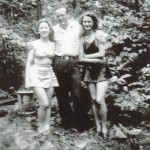 as had their parents before them, and secretly hope that horrible mini skirt craze would never come back again, and if it did, I’m sure they hoped that it would wait until they had their daughters grown up and married off. Then it would be their children’s problem. Of course, there really is nothing new under the sun, and they had somehow forgotten just how risqué their own parents thought their styles were…or maybe they hadn’t, and they just hoped their children would never know just how risqué they were, because somehow that was different, or maybe it was just that these were their kids, and they suddenly knew just how their parents had felt all those years ago, and they weren’t sure they liked it either.
as had their parents before them, and secretly hope that horrible mini skirt craze would never come back again, and if it did, I’m sure they hoped that it would wait until they had their daughters grown up and married off. Then it would be their children’s problem. Of course, there really is nothing new under the sun, and they had somehow forgotten just how risqué their own parents thought their styles were…or maybe they hadn’t, and they just hoped their children would never know just how risqué they were, because somehow that was different, or maybe it was just that these were their kids, and they suddenly knew just how their parents had felt all those years ago, and they weren’t sure they liked it either.
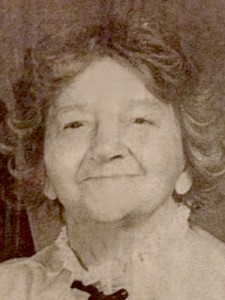 As I was reading the notes I was given on Frederick Schumacher and his wife, Anna Richard Schumacher, I read that they lost their home to a fire in 1956. I can’t imagine losing your home and all of your precious memories in a fire, and yet it does happen. I don’t know what memories Fred and Anna lost, but my guess is that it included photographs of their babies as they grew up. Those are things that are so hard to get back. All you can do is hope that someone among your friends and family members has pictures they can share with you. I’m sure it was such a shock…everything was gone…in an instant. All you had left was your family and the clothes on your back…and you were grateful. How could you feel gratitude after such a devastating loss? Of course, it is because your family had survived, and in reality, everything else is just stuff. Nevertheless, as time goes by, you begin to realize that you really lost a lot that dreadful day. It’s no wonder you seem to be having a hard time getting past it. I have to wonder if sleeping at night is difficult, because you feel a deep need to be on your guard. Still, you have to move forward for your family.
As I was reading the notes I was given on Frederick Schumacher and his wife, Anna Richard Schumacher, I read that they lost their home to a fire in 1956. I can’t imagine losing your home and all of your precious memories in a fire, and yet it does happen. I don’t know what memories Fred and Anna lost, but my guess is that it included photographs of their babies as they grew up. Those are things that are so hard to get back. All you can do is hope that someone among your friends and family members has pictures they can share with you. I’m sure it was such a shock…everything was gone…in an instant. All you had left was your family and the clothes on your back…and you were grateful. How could you feel gratitude after such a devastating loss? Of course, it is because your family had survived, and in reality, everything else is just stuff. Nevertheless, as time goes by, you begin to realize that you really lost a lot that dreadful day. It’s no wonder you seem to be having a hard time getting past it. I have to wonder if sleeping at night is difficult, because you feel a deep need to be on your guard. Still, you have to move forward for your family.
A fire affects everyone in the family…even grown children who have homes of their own. When  fire destroyed my Uncle Jim Wolfe’s home on Wolfe Mountain outside of Newport, Washington, there was no way to get help up there in time. The road is just too rough and the area too remote to get fire trucks up there, so when Uncle Jim’s home caught fire, the only thing they could do was to try to save what they could…and it was not much. All of the memories were lost…pictures, keepsakes from my Aunt Ruth’s life, all of the pictures of the childhood days of my cousins, as well as all of Uncle Jim’s items for day to day living. Before long, Uncle Jim needed to move into a nursing home where he could get 24 hour care for his Alzheimer’s Disease. For my cousin, Shirley it was like losing one more of her precious memories…having her dad living just down the road from her. Her mother, my Aunt Ruth had passed away, in 1992, and this was just one more blow to Shirley.
fire destroyed my Uncle Jim Wolfe’s home on Wolfe Mountain outside of Newport, Washington, there was no way to get help up there in time. The road is just too rough and the area too remote to get fire trucks up there, so when Uncle Jim’s home caught fire, the only thing they could do was to try to save what they could…and it was not much. All of the memories were lost…pictures, keepsakes from my Aunt Ruth’s life, all of the pictures of the childhood days of my cousins, as well as all of Uncle Jim’s items for day to day living. Before long, Uncle Jim needed to move into a nursing home where he could get 24 hour care for his Alzheimer’s Disease. For my cousin, Shirley it was like losing one more of her precious memories…having her dad living just down the road from her. Her mother, my Aunt Ruth had passed away, in 1992, and this was just one more blow to Shirley.
Fires destroy the dreams, as well as the memories, of those who have an unfortunate encounter with them. For my cousin, Shirley, it has meant trying to find friends and family  who might have childhood pictures that they could copy for her. We have been searching for pictures, but have not found a whole lot for her. I am still hopeful that someday we will stumble across a huge cache of pictures that will fill all the memory holes in her life right now. It is amazing to me that in this day and age, we are still unable to save some homes from fire. It’s not so much a remote home, like my Uncle Jim’s, but even homes in town, are completely destroyed be fire. Still there are factors like how long it took to report, and what type of fire it was that can affect the ability to save it too. Whatever the reason, dreams and memories are lost in the twinkling of an eye, and they are really hard to get back.
who might have childhood pictures that they could copy for her. We have been searching for pictures, but have not found a whole lot for her. I am still hopeful that someday we will stumble across a huge cache of pictures that will fill all the memory holes in her life right now. It is amazing to me that in this day and age, we are still unable to save some homes from fire. It’s not so much a remote home, like my Uncle Jim’s, but even homes in town, are completely destroyed be fire. Still there are factors like how long it took to report, and what type of fire it was that can affect the ability to save it too. Whatever the reason, dreams and memories are lost in the twinkling of an eye, and they are really hard to get back.
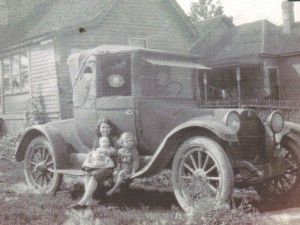 I was looking at family pictures the other day, and I noticed just how many of these pictures used cars as a backdrop for the picture. I began to wonder why that is. Maybe in the beginning, when cars first came out, it was because cars were such a novelty. I can completely understand having your picture taken with a treasured automobile, or one that has been fixed up as a show piece, but these were daily drivers, so what was the draw to include them in the picture? I mean, it’s just a car…right?
I was looking at family pictures the other day, and I noticed just how many of these pictures used cars as a backdrop for the picture. I began to wonder why that is. Maybe in the beginning, when cars first came out, it was because cars were such a novelty. I can completely understand having your picture taken with a treasured automobile, or one that has been fixed up as a show piece, but these were daily drivers, so what was the draw to include them in the picture? I mean, it’s just a car…right?
Nevertheless, here in the family history, I find shot after shot of people sitting on the running board, standing beside and even sitting on their cars in the picture. Personally I have always preferred some beautiful scenery as the backdrop for the pictures I take or those I have taken by someone else, but maybe that’s just me. The latest thing in pictures seems to be the railroad tracks, not that the railroad tracks are a totally new idea either; or even pipes in an alley or an alley stairway. I suppose these are something different, and that is the draw, but they are not my favorite scenes.
The car, however, seems to be the backdrop of choice in all sides of my family. I guess that we all just love our cars. Even I have had my picture taken in a car, back when we owned a sports car. Maybe it is a status symbol, and we just have to show the world that we are doing quite well financially. That might work, except, my family doesn’t really seem the type to feel the need to flaunt the things they have been blessed with. No, for them, I just think they really liked their cars and wanted to have a memory of them.
In the family history writings of my Uncle Bill, you will often find that he tells you the year,  make and model of the car he was driving at the time of an event. He really liked cars, and he felt that they were a part of the family history, because they depicted the way things were in the family at that time in history. I guess that in the modern era of cars, computers, planes, and other such advanced technology, we will see more and more pictures of people with things that are in some way of value to them. And maybe that it why I like having pictures of scenery in my pictures. I love to hike, so nature scenes are the things I like…the things that have value to me….making me the same as everyone else who takes pictures with the important things in life. Who knew?
make and model of the car he was driving at the time of an event. He really liked cars, and he felt that they were a part of the family history, because they depicted the way things were in the family at that time in history. I guess that in the modern era of cars, computers, planes, and other such advanced technology, we will see more and more pictures of people with things that are in some way of value to them. And maybe that it why I like having pictures of scenery in my pictures. I love to hike, so nature scenes are the things I like…the things that have value to me….making me the same as everyone else who takes pictures with the important things in life. Who knew?

